
How Mobile Gaming Is the Most Profitable And Popular Industry | Game App Development Benefits
5246 Views 11 min January 5, 2022


Imagine spending thousands of dollars on developing a mobile game app with amazing graphics, addictive gameplay, and everything players would desire. You launch the game with excitement, expecting that people will download it. But months later, your install numbers barely move.
But why does your game fail? Well, it is because today’s games don’t sell themselves; strong user acquisition in gaming apps does that, which you ignore.
Millions of games compete for attention every year, but effective mobile gaming UA strategies are what make the difference. It decides whether your game app fades into the background or dominates the charts.
Regarding market size, the global gaming market is projected to reach $126.06 billion by the end of 2025. Statista stated that it will surpass $163.98 by 2030 with a CAGR of 5.40% between 2025 and 2030.
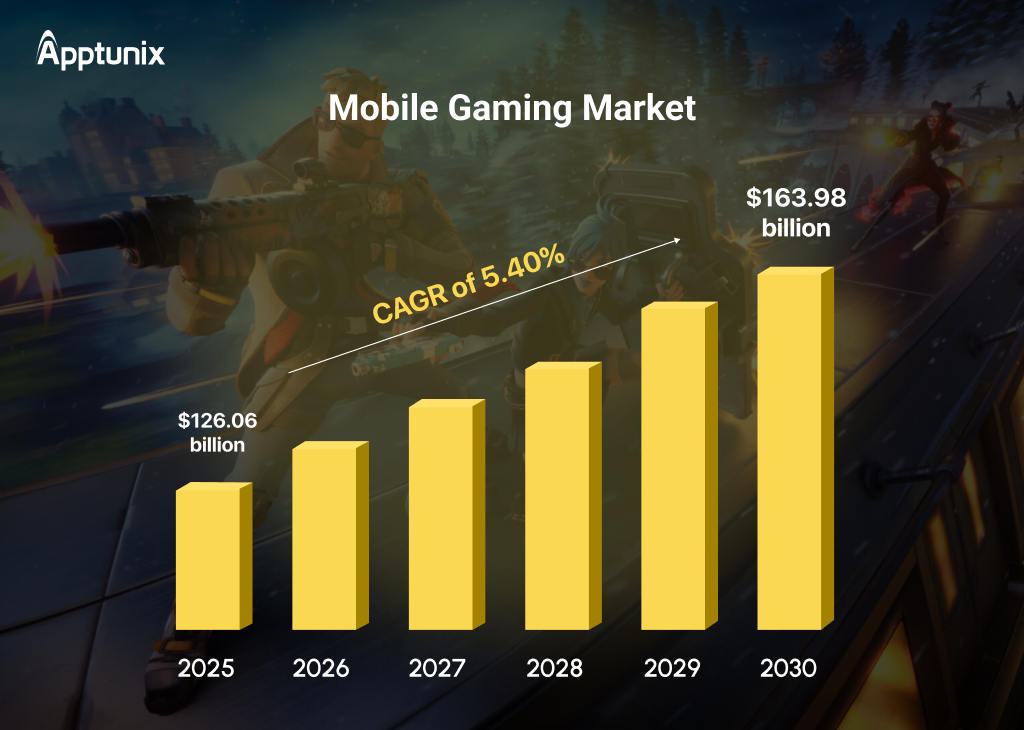
Entrepreneurs and investors are heavily investing in mobile game apps, but most of them fail due to a lack of balance in mobile game user acquisition and retention. But worry not, we’re here to help you tackle this obstacle.
Here, we’ll break down what UA in mobile gaming really means and its importance. You will also examine top strategies, types of mobile game user acquisition, challenges, the future, etc.
Let’s Get Started!
UA in mobile gaming is a strategic approach to attract and convert users to the product and services. In gaming, it refers to the process of attracting new players to download and engage with a game app.
UA’s aim is not just getting installed, but it’s also about reaching the right users at the right time who will play consistently, make in-app purchases, and contribute to long-term growth.
User acquisition in gaming apps is the backbone of mobile game success in a world where thousands of games get launched on app stores and the Play Store every month. Publishers and developers use a mix of paid campaigns like ads, influencer promotions, partnerships, etc., and organic methods like social media, app store optimization, and referrals.
This helps them to stand out in today’s highly competitive gaming industry. UA’s main goal is to bring high-quality users at the lowest possible cost while maximizing revenue and retention. An innovative mobile game experience risks getting lost in the crowd without a solid UA strategy.
Mobile game app development is not the end, but it’s the beginning in today’s crowded world of mobile gaming. Today, it is essential to approach user acquisition to make your game visible, grow downloads, and sustain long-term success. Here are the reasons for needing customer acquisition:
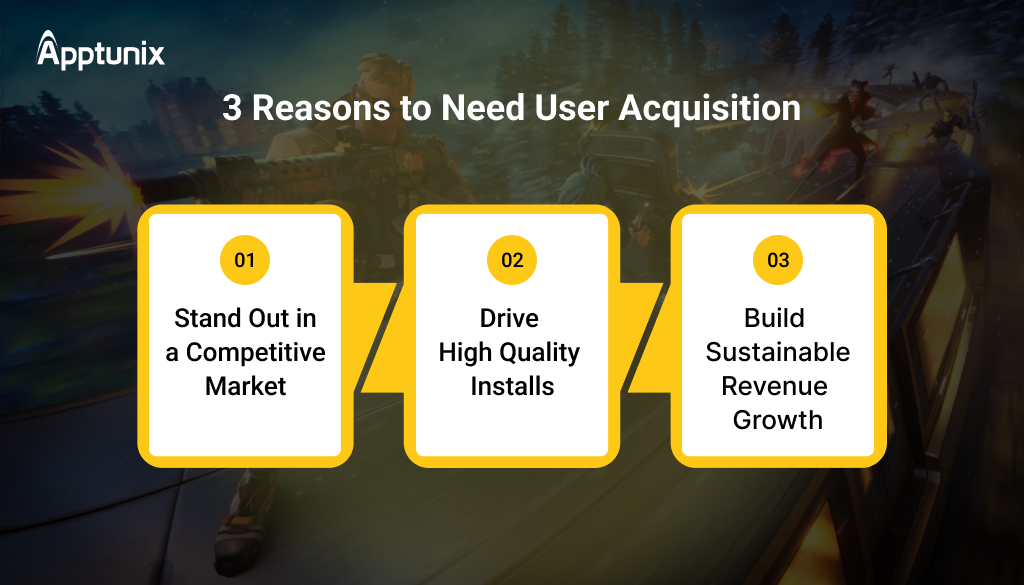
1 Stand Out in a Competitive MarketDo you know that over 500 mobile games are submitted to app stores daily, making mobile game user acquisition imperative to stand out? Visibility is the biggest challenge for Android & iOS game app developers or publishers since thousands of new games are being released every month.
To make the game app stand out in a competitive market, UA reaches the right audience through targeted campaigns, app store optimization, and promotions. Even the best games risk going unnoticed without UA.
2 Drive High Quality InstallsAs of 2025, 77% of users stop using a game app within 3 days of its installation if it’s not the right fit for them. As a result, it is essential to drive high-quality installs since not all downloads are equally effective.
UA in mobile gaming app ensures you attract genuinely interested players to your game, and they are more likely to stay, engage, and spend. You can improve retention rates and maximize lifetime value by focusing on quality over quantity with the help of UA.
3 Build Sustainable Revenue GrowthMobile games in 2023 were responsible for generating more than $90 billion in revenue, and the UA and retention strategies were instrumental in fueling this. Good user acquisition tactics not only drive installs but also monetize, too.
Effective UA plans help sustain profits in the long run and contribute to the success of your game app in a competitive market. The acquisition of the appropriate users will result in stable income from various sources of monetization, such as in-app purchases, advertisements, or subscriptions.
The two main types of UA in mobile gaming are paid UA and organic UA. However, both of them contain several different types of UA approaches. Let’s find out how each serves a unique purpose in helping mobile games grow:
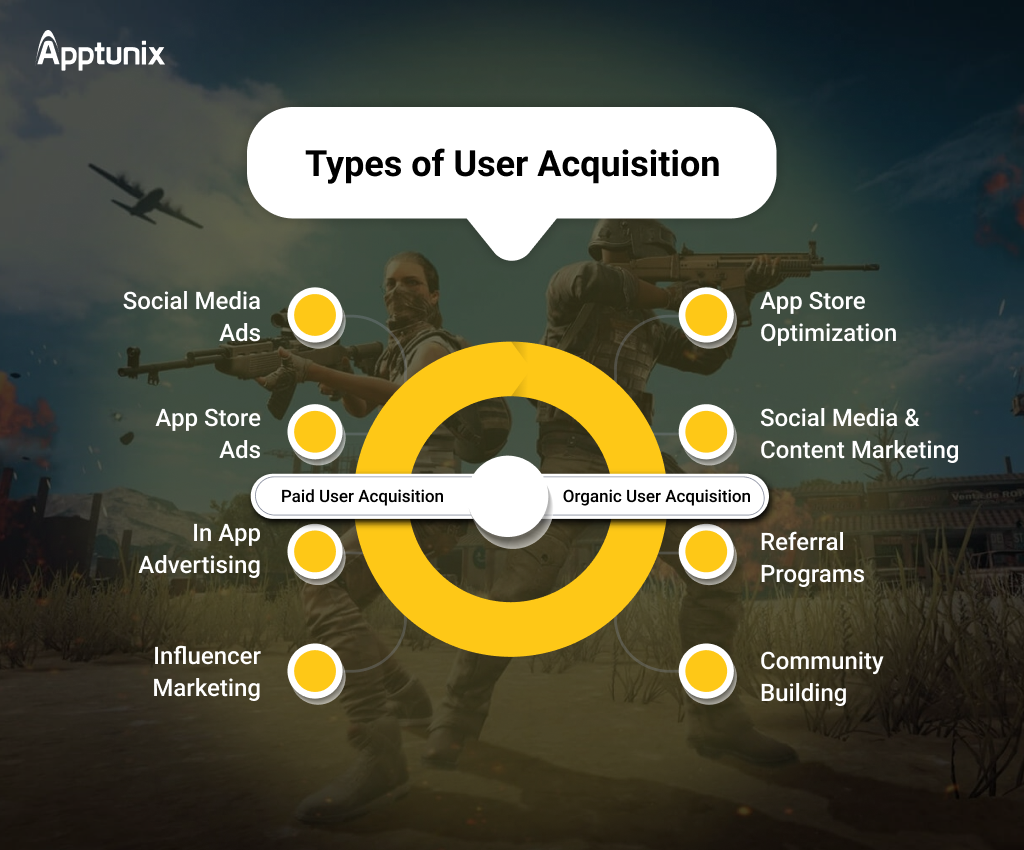
1 Paid User AcquisitionPaid user acquisition for games is a flawless approach for achieving fast growth, global reach, and immediate visibility. It basically involves spending money on campaigns to attract players, scale installs quickly, and ultimately generate high revenue. Paid UA can be costly if not managed with the right targeting and tracking, but it gives good ROI.
The different types of paid UA include:
Social media platforms like Facebook, Instagram, TikTok, etc., allow hyper-targeted campaigns to reach players based on interests and behavior. This leads the mobile game apps to get quick installs but requires constant budget optimization.
Google Play promotions and Apple Search Ads help mobile games appear at the top of search results by boosting visibility. This kind of paid UA is highly effective for competitive game categories.
Advertising your game app to other games means cross-promoting through established games, which helps you tap into an audience already interested in mobile gaming. In-game advertising is a proven way to convert active gamers into loyal users.
Influencer marketing is also an effective way to promote your game app. It allows you to partner with gaming influencers and streamers, which helps build credibility and encourages players to try the game. Influencer reviews can drive thousands of downloads in days.
2 Organic User AcquisitionOrganic user acquisition in gaming apps is also a strategic way to boost your game’s visibility. It focuses on growing installs without direct ad spend, relying on trust and community. This is a time-consuming method, but scale your game for the long term by creating loyal players. The different types of organic UA include:
ASO is one of the best organic user acquisition strategies because it optimizes keywords, icons, and screenshots and helps in improving discoverability, which drives organic downloads. It is the backbone of sustainable growth in mobile gaming app development.
Content marketing and social media promotions are affordable mobile gaming UA strategies that create an enduring brand presence. They generate buzz and draw gamers organically with interesting postings, gaming videos, trailers, etc.
Word-of-mouth referrals bring the most engaged users. Referral programs include incentivizing players to invite friends, which helps the game expand its user base at little cost.
Community building on platforms like Reddit, Discord, etc., encourages discussions, loyalty, and word-of-mouth growth. Building strong communities also gives valuable feedback for future updates.
Creating a successful mobile game app’s user acquisition strategy needs more than just ad spend. It’s all about attracting the right users and keeping them emotionally engaged to maximize long-term value. From knowing your target audience to balancing UA with retention strategies, here are the five tips that will help you create a successful UA for your mobile game app development:
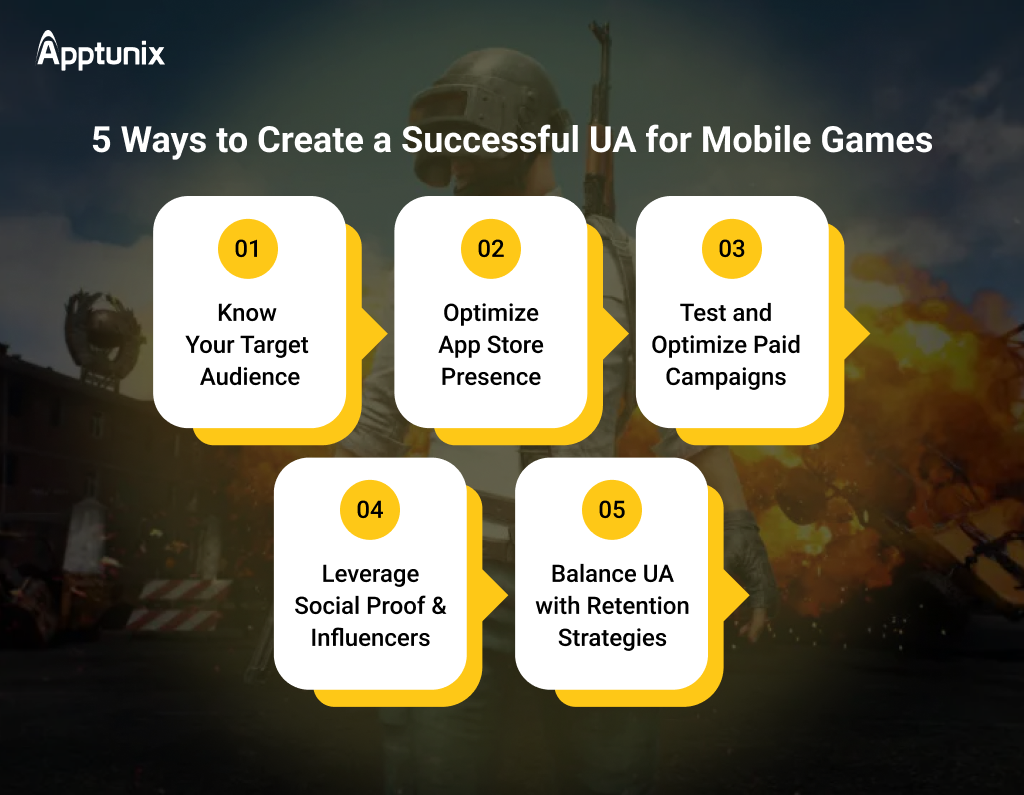
1 Know Your Target AudienceThe first way to create a successful user acquisition is to understand your ideal players. Define their interests, gaming behaviors, demographics, etc., to create campaigns that truly connect.
For example, an FPS game targets competitive gamers, but a puzzle game app attracts casual players. Here, the more specific your targeting of players, the higher the chances of attracting players who not only download your game app but also play for a long time.
2 Optimize App Store PresenceListing your mobile gaming app is often the first impression players get of your game. As a result, optimizing titles with relevant keywords, high-quality screenshots, and adding engaging gameplay videos or trailers are essential.
You should make a strong ASO strategy to improve your game’s visibility, boost organic downloads, and enhance credibility. Remember, games with optimized app store listings experience significant growth without heavily investing in paid ads.
3 Test and Optimize Paid CampaignsInvesting in paid ads requires careful testing. To experiment with ad creatives, audience segments, and ad copy, use A/B testing. Apart from that, measure performance against KPIs like CPI and ROAS, and later refine campaigns.
Testing and optimizing paid gaming app UA campaigns ensures spending on valuable users. This also reveals insights into what resonates most with players, making your user acquisition more likely to be impactful over time.
4 Leverage Social Proof and InfluencersToday, players trust other players or authentic influencers more than ads. Eventually, build credibility by encouraging positive reviews, ratings, and testimonials. Choose the players or streamers who already have the attention of your target audience.
Famous streamers’ shout-outs or gameplay videos can boost your game downloads overnight. By combining social proof with influencer marketing, you can create strong, trust-based campaigns that effectively boost UA.
5 Balance UA with Retention StrategiesIt is crucial to balance UA in mobile gaming app with retention strategies like daily rewards, seasonal events, or new content updates to encourage players to return. Keep users engaged to boost downloads and make your application successful.
By integrating retention strategies and balancing them with mobile game user acquisition, your game app not only grows in downloads but also builds a loyal customer base. This leads to long-term sustainability and higher lifetime value per player.
Let’s examine customer acquisition and retention by comparing them both and making a balance.
Developers often face a tough choice while choosing between UA and retention in mobile app development. Should they spend more on acquiring new players or keeping existing ones more engaged? After reading the tips, you have understood the importance of balancing both strategies.
Let’s understand both more clearly:
CA or UA brings fresh users, increases visibility, and drives early growth. It is imperative to scale the game quickly and reach new customers around the world.
On the other hand, retention mainly focuses on keeping exciting players engaged, loyal, and active for the long term. Retention strategies help games reduce churn and maximize lifetime value.
Relying just on acquisition can be expensive, and relying exclusively on retention restricts growth, so striking a balance between the two is essential for long-term success.
| Aspect | User Acquisition | Retention |
|---|---|---|
| Goal | Attract new players and boost installs | Keep players active and engaged |
| Methods | Paid ads, influencer marketing, ASO, social media campaigns | Rewards, regular updates, events, and community building |
| Cost | Recurring new users are more expensive than retaining the current ones | Lower cost since retaining players is cheaper than recurring new ones |
| Impact | Quick growth and visibility in App Store and Play Store | Long-term revenue and stronger player loyalty |
| Stat | 65% of new installs came from paid gaming app UA campaigns in 2023 | A 5% increase in retention can raise 25%–70% of sales |
Indeed, user acquisition offers several benefits, but it also comes with several challenges that mobile game app developers and publishers must overcome. From rising mobile game advertising costs to balancing UA and retention, here are the four major challenges that you must face:
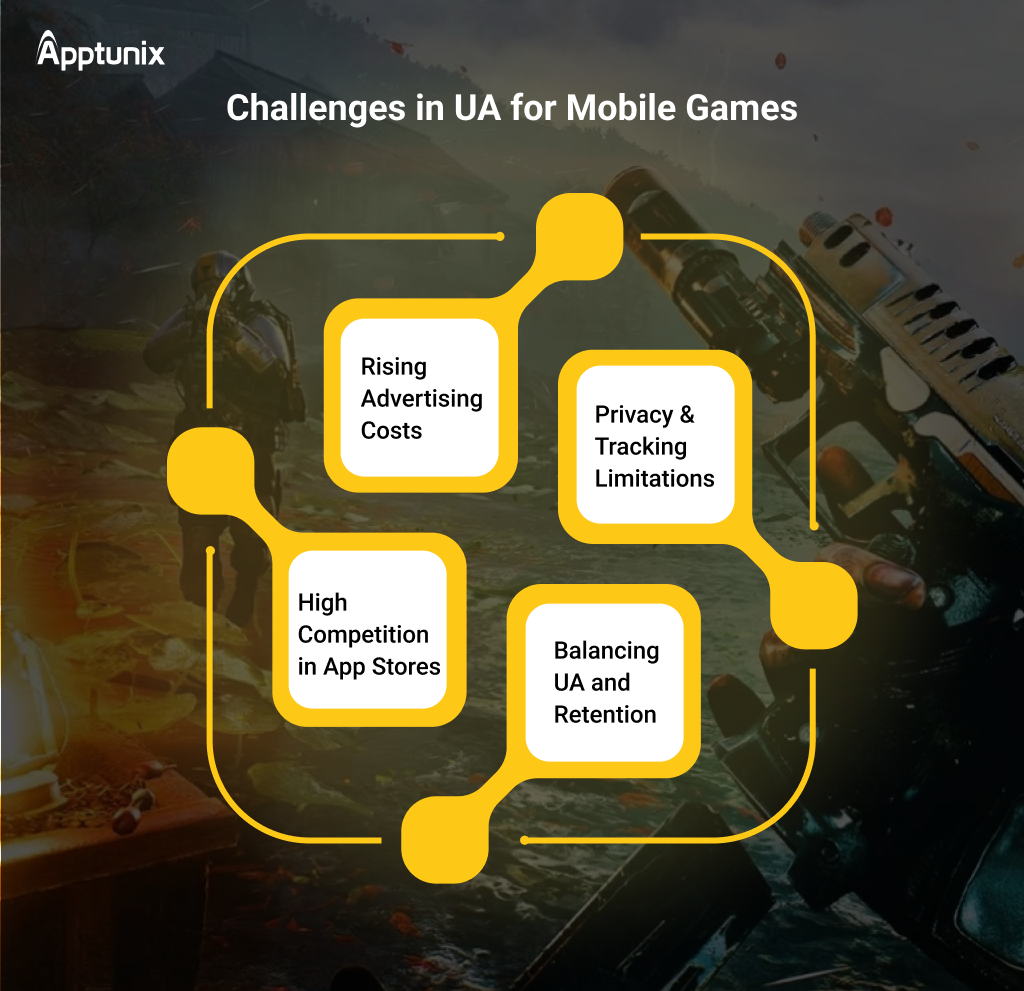
Challenge: Advertising costs are increasing daily on Facebook, TikTok, and Google, due to high competition. As a result, small studios struggle to compete with big publishers who dominate with larger budgets.
Solution: You can tackle this challenge by focusing on cost-efficient campaigns. This can be achieved by running A/B tests, refining targeting, and leveraging cheaper alternatives like cross-promotions and influencer collaborations.
Challenge: Apple’s ATT policy and privacy laws that are more stringent have made it difficult to follow users and maximize the campaigns. The limited data reduces the effectiveness of targeting and increases UA expenses.
Solution: To resolve this, you must shift towards contextual advertising and first-party data strategies. Encourage users to opt in for tracking through transparency and offer value-driven incentives to gather actionable insights.
Challenge: The competition in both the App Store and the Play Store is undeniable. Every month, thousands of new games get launched, which makes it a constant uphill battle for publishers. Even great games risk being buried in app store and Play Store charts.
Solution: The best way to compete with thousands of game apps is to invest in app store optimization with keyword-rich titles, engaging visuals, and positive reviews. You can gain visibility by combining ASO with community mobile game marketing and social buzz.
Challenge: Publishers or iOS & Android mobile game app developers spend money on UA but fail to retain players, which leads to wasted budgets and poor lifetime value.
Solution: They fail because they focus solely on spending money on UA, rather than on retention strategies. You must pair UA with strong retention tactics like daily rewards, seasonal updates, and community events.
UA in mobile gaming is evolving rapidly. Top mobile game app developers must think about how they attract and engage players by focusing on new technologies, shifting user behaviors, and tighter privacy laws. The five key trends that are shaping the future of mobile game user acquisition are as follows:
AI-driven gaming app UA campaigns are making user acquisition smarter by predicting player interests, analyzing user behavior, and optimizing ad placements in real time. It leads to a reduction in ad spend and boosts the game app’s return on investment.
Personalization in mobile game advertising is gaining attention day by day since generic ads are losing effectiveness. The mobile gaming future definitely lies in personalized campaigns, showing players ads that reflect their gaming habits and preferences.
Influencers and gaming communities will undoubtedly drive discovery as trust in traditional ads declines. Today’s Gen Z players rely on streamers and peer recommendations before downloading new games.
Contextual targeting and first-party data will dominate due to data restrictions, such as Apple’s ATT. Game app developers will definitely focus on transparent and value-based strategies to build trust while acquiring users.
Technologies like augmented reality, virtual reality, and blockchain will reshape how players interact with games. User acquisition campaigns include immersive experiences, NFTs, and virtual communities to attract next-gen players.
Also Read: How to Develop a Game Like Call of Duty?
The UA cost in mobile app development is high compared to other types of app development. It varies by game genre, platform, region, competition, and, of course, marketing channel. The average cost of user acquisition is around $2-$6 per install, but it can be higher for hardcore games on iOS.
Let’s understand this with an example: the casual game cost per install (CPI) is somewhere around $2.50 for iOS; however, it will be around $1.50 for Android. On the other hand, high-end games or strategy games require a high cost to get promoted; it may cost around $6 for iOS.
Understanding CPI or UA clearly helps developers or publishers to optimize mobile game marketing budgets and ensure profitability in today’s highly competitive gaming industry.
Analyze the table to understand the cost more clearly:
| Game Genre | iOS CPI | Android CPI | Notes |
|---|---|---|---|
| Casual Games | $2.5 | $1.5 | Lower cost, wider audience, higher volume |
| Mid Core (RPG, Action) | $4 | $3 | Competitive niche, moderate targeting costs |
| Hardcore/Strategy | $6 | $4.5 | Premium audience, highest UA costs |
Mobile game app development cost depends on game type, complexity, architecture, graphics, features, integrations, and several development process or post-maintenance factors. The cost can start from $10,000 for a simple 2D game; however, it can go up to $100,000 or even $500,000 for a high-end or strategy game.
| App Complexity | Estimated Cost |
|---|---|
| Simple 2D Game | $10,000-$25,000 |
| Mid-Level Game | $30,000-$100,000 |
| High End 3D/ Strategy Game | $100,000-$500,000 |
The factors that majorly influence the cost to develop a mobile game app are:
Apart from that, marketing and user acquisition also add to the overall investment required to make a game successful.
Today, developing a mobile game app isn’t enough; you need the right strategies to acquire users, retain them, and turn engagement into revenue. To let you achieve this, Apptunix helps entrepreneurs or investors worldwide by providing mobile app development solutions, from concept and launch to user acquisition and retention.
Apptunix, a leading mobile app development company, provides end-to-end mobile game app development and growth solutions that ensure your game stands out and succeeds.
Our expertise in developing high-performing game apps or proven mobile gaming UA strategies helps you minimize acquisition costs, boost retention rates, and maximize LTV. We believe in transforming the game into a profitable business, not just another app in the store.
So what are you waiting for? Level up your mobile game by partnering with Apptunix today, and let’s develop a mobile game app that players love and investors admire.
Q 1.What is user acquisition?
UA is the process of attracting new users to a product, service, or application with the help of marketing strategies. Basically, user acquisition involves reaching the right audience, convincing them to engage, and converting them into active users.
Q 2.What is user acquisition in a mobile gaming app?
UA in a mobile gaming app is all about getting players to download and play the game. It follows methods like paid ads, social media, influencer marketing, ASO, etc., to attract the target players and boost revenue.
Q 3.How much does user acquisition cost in mobile gaming?
The average cost of user acquisition is around $2-$6 per install, but it can be higher for hardcore games on iOS. For a casual game, it costs $2.5 for iOS and $1.5 CPI for Android. For a mid-core game, it costs $4 for iOS and $3 CPI for Android. But for a hardcore strategy game, it costs $6 for iOS and $4.5 CPI for Android.
Q 4.What are the types of user acquisition strategies in gaming?
There are mainly two types of user acquisition strategies: paid or organic. Paid UA includes ads, influencer campaigns, partnerships, and sponsorships. On the other hand, organic UA includes ASO, social sharing, community building, and referral programs.
Q 5.What is the difference between user acquisition and retention?
User acquisition focuses on bringing in new players to install and try a game, while retention is about keeping those players engaged, active, and loyal over time. Both are essential for building sustainable growth.
Q 6.How long does it take to build a mobile game app?
The time to develop a mobile game app is somewhere between 3 and 12 months. The duration depends on app complexity, feature integrations, graphics, and testing. A simple 2D game takes less to build than a high-end 3D or strategy game.
Q 7.How to make money with mobile game app development?
The mobile game generates revenue through in-app purchases, ads, subscriptions, and premium versions. It also earns money through partnerships and sponsorships. However, you must choose the revenue model that ensures steady revenue while enhancing player engagement.
(1 ratings, average: 1.00 out of 5)
Get the weekly updates on the newest brand stories, business models and technology right in your inbox.
Book your free consultation with us.
Book your free consultation with us.





